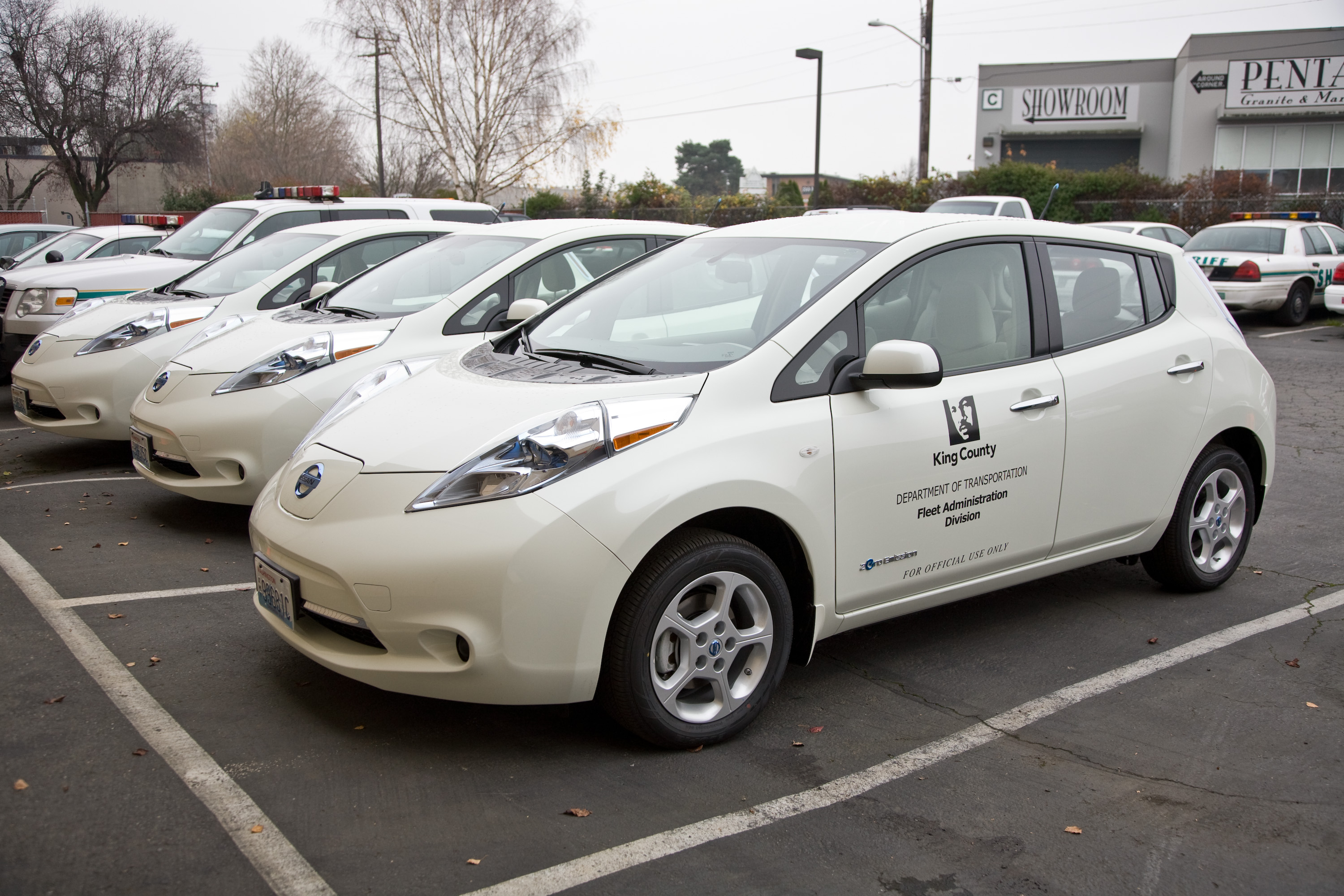Vehicles
Transportation is the largest source of greenhouse gas emissions in King County, accounting for nearly half of all GHG emissions that occur within King County’s geography.
King County is continually working to improve vehicle technology, phase in cleaner fuels, and reduce emissions through thoughtful operating practices for both Metro Transit and an extensive vehicle fleet that supports government functions.

Policy and Goals:
As stated in King County's Sustainable Purchasing Executive Policy (CON 7-22-EP),
- Purchase alternative fuel vehicles
As outlined in King County’s 2020 Strategic Climate Action Plan,
- In its vehicle operations, King County will reduce GHG emissions by 45% by 2025 and 70% by 2030, compared to a 2017 baseline
- Reduce transportation fuel GHG emissions intensities by at least 20% by 2030, compared to 2017 levels
As Outlined in 18.22 Electric Vehicles for County
- 18.22.01 Electric vehicles. The following King County vehicle electrification goals are established:
-
A one-hundred-percent zero-emission revenue bus fleet by 2035;
-
A sixty-seven-percent zero-emission ADA paratransit fleet by 2030;
-
A one-hundred-percent zero-emission rideshare fleet by 2030;
-
Installation of one hundred twenty-five chargers at King County-owned park and rides by 2030;
-
Fifty percent of light-duty vehicles are transitioned to electric by 2025 and one hundred percent by 2030;
-
Fifty percent of medium-duty vehicles are transitioned to electric by 2028 and one hundred percent by 2033;
-
Fifty percent of heavy-duty vehicles are transitioned to electric vehicles by 2038 and one hundred percent by 2043; and
-
Installation of one hundred fifty chargers by 2030 in county facilities.
Choose
- electric or hybrid vehicles
- fuel-efficient or alternative fuel vehicles
- right sizing
- vehicle sharing
- route optimization
Avoid
- gas-powered vehicles
- low fuel economy vehicles
End of Life
- trade-in
- donate
- sell
Types of Vehicles
| Alternative Fuel | Description |
|---|---|
| Electric | All-electric vehicles (EVs) use a battery to store the electrical energy that powers the motor. These vehicles can greatly reduce fuel costs and greenhouse gas emissions. |
| Hybrid-Electric | Powered by both gasoline and a battery that recharges as the vehicle brakes. These vehicles can greatly reduce fuel costs and greenhouse gas emissions. |
| Biodiesel (B99-B100) | Biodiesel is an alternative fuel made by reacting animal or vegetable fats with alcohol. Biodiesel refers to the pure fuel before blending with diesel fuel. (80% petroleum diesel, 20% biodiesel blend). Almost all conventional diesel vehicles are capable of running on biodiesel. |
| Biodiesel (B20) | Biodiesel is an alternative fuel made by reacting animal or vegetable fats with alcohol. Biodiesel refers to the pure fuel before blending with diesel fuel. (80% petroleum diesel, 20% biodiesel blend). Almost all conventional diesel vehicles are capable of running on biodiesel. |
| Liquefied Natural Gas (LNG) | Natural gas is converted into LNG, by a process called liquefaction, into a clear, colorless liquid. Tailpipe emissions from natural gas vehicles are comparable to those of gasoline and diesel vehicles equipped with modern emissions controls. There are light-, medium-, and heavy-duty natural gas vehicles available from original equipment manufacturers, as well as options available through retrofitters. |
| Ethanol (E85) | Made from corn and other plant materials, which capture carbon dioxide when grown, ethanol is typically blended with gasoline to produce a cleaner-burning fuel. It contains less energy than gasoline, leading to lower fuel economy. Flexible fuel vehicles (FFVs) have an internal combustion engine and are capable of operating on gasoline and any blend of gasoline and ethanol up to 83%. E85 (or flex fuel) is a gasoline-ethanol blend containing 51% to 83% ethanol. |
| Compressed Natural Gas (CNG) | CNG is a readily available alternative to gasoline that’s made by compressing natural gas to less than 1% of its volume at standard atmospheric pressure. Consisting mostly of methane, CNG is odorless, colorless and tasteless. Tailpipe emissions from natural gas vehicles are comparable to those of gasoline and diesel vehicles equipped with modern emissions controls. There are light-, medium-, and heavy-duty CNG vehicles available from original equipment manufacturers, as well as options available through qualified system retrofitters. |
| Propane | Also known as liquefied petroleum gas (LPG), a gas normally compressed and stored as a liquid, typically used in high-mileage vehicles due to its potential for lower maintenance costs. There are light-, medium-, and heavy-duty propane vehicles available from original equipment manufacturers, as well as available through retrofitters. |
| Hydrogenation-Derived Renewable Diesel | Produced with fats or vegetable oils—alone or blended with petroleum—and refined by a hydrotreating process. Also known as green diesel. Almost all conventional diesel vehicles are capable of running on hydrogenation-derived renewable diesel. |
| Fuel Guidance | |
|---|---|
|
The U.S. Environmental Protection Agency (EPA), U.S. Department of Energy, and U.S. Department of Transportation certify the fuel economy labels for new vehicles sold in the U.S., which outline the vehicle’s fuel economy, fuel cost, greenhouse gas rating, and smog rating. |
U.S. Department of Energy: Alternative Fuels Data Center
Sustainable Facilities Tool: Green Procurement Compilation (GPC) Tool
Western Washington Clean Cities: Alternative Fuels
Atlas Public Policy: Fleet Procurement Analysis Tool
Contact Us
Phone: 206-263-9400
TTY Relay: 711
Fax: 206-296-7676

 Translate
Translate